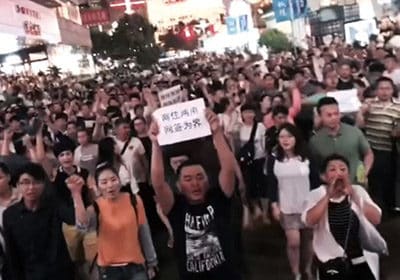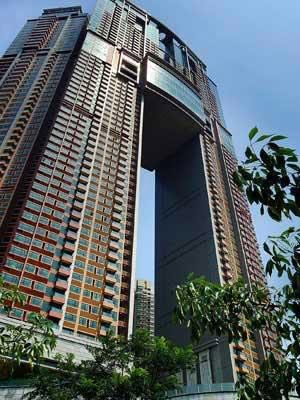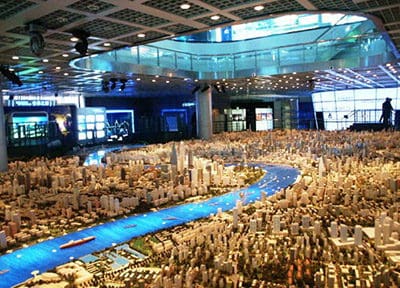
Protestors took to the Shanghai’s streets in June to protest the commercial-titled housing ban
Faced with skyrocketing housing prices in 2016, during the first half of this year, China implemented a fresh round of measures aimed at suppressing demand for housing, including a clampdown on financing for the real estate sector, and direct controls by local governments over the activities of developers and service providers.
By far the most controversial set of measures, however, were sudden bans on sales of commercial-titled apartments in the country’s biggest cities.
After homes built on commercial-zoned property accounted for the majority of housing sales in Shanghai in 2016, this year the sudden crackdown on this gray-market housing brought on street protests in both Shanghai and Beijing.
While the local governments of both cities ultimately revised their bans to rescue angry homebuyers, the administrative stumbles reveal some of the challenges facing China’s highly policy-driven residential market, while also laying bare risks faced by even some of the most experienced developers operating on the mainland.
Don’t Mess with Home Values

The bilingual signs were a media-friendly touch
Street protests in Beijing over the capital’s ban on transactions involving commercial-titled apartments during May were followed by angry home buyers filling Shanghai’s East Nanjing Road pedestrian street during June to voice their displeasure over even stricter measures in the eastern China metropolis.
The protests came after Beijing restricted purchases of new commercial-titled homes to corporations only, and required buyers of second-hand properties to have paid local social security and taxes for the last five years. The measures also forbade mortgage financing for commercial-titled apartments.
Shanghai’s restrictions went a step further by completely banning transactions involving commercially titled homes in both the first and second-hand markets and requiring that such properties be refitted for commercial use before any sales could be completed.
The measures in both cities meant that billions of yuan in value evaporated from the market, with millions of home owners said to be affected. In Shanghai the commercial-titled apartment ban was estimated to affect around 17 million square meters of space, according to an account in the South China Morning Post.
Homeowners Bailed Out
Following the protests in Beijing, officers of the city’s Municipal Commission of Housing and Urban-rural Development stepped back from the strictest provisions of their ban and mediated between developers and home buyers, so that owners could take possession of their flats, but without titles issued.
In Shanghai, the protests were resolved when the government pledged to “earnestly safeguard the legitimate rights and interests of buyers,” by allowing home buyers to take possession of their properties and relaxing restrictions on the secondary market for commercial-titled homes.
In addition to the large amount of commercial-titled homes in Shanghai and Beijing, the gray market housing is also common in other leading real estate markets such as Guangzhou, Shenzhen, Hangzhou, Suzhou, Chongqing and Chengdu, where government restrictions on residential property sales have fueled demand for alternative housing opportunities.
Developers Still on the Hook

Sun Hung Kai’s Shanghai Arch, where homes sell for up to RMB260k/sqm is among the affected projects
While consumers were granted relief, developers who had invested in building housing projects on commercially zoned land were less fortunate. Local builders including China Evergrande Group, China Vanke, Longfor Properties, Greenland Group and Beijing Urban Construction Group were banned from selling more units at projects in Shanghai and Beijing.
Among the foreign-invested developers caught in the crackdown was Hong Kong’s biggest home builder, Sun Hung Kai Properties, whose high-end Shanghai Arch Project in Lujiazui was built on commercial-titled land.
Penalties for developers pursuing commercially titled housing projects also took a step up in 2017. While in Beijing fines from city planning authorities for unauthorized alteration of construction planning had been below RMB 10,000, following the new restrictions, developers have been fined millions of yuan, according to press reports. In Shanghai, Greenland Group was suspended from purchasing new land because of its gray-market activities.
When Commercial-Titled Homes Become the Norm
The 2017 restriction on commercial-titled housing targeted a two-decade-old practice that had grown into a mainstream activity in response to restrictions on residential real estate sales.
Commercial-titled housing is said to have first appeared in Shenzhen in the 1990s following the collapse of a commercial real estate bubble in the southern metropolis. With a glut of unfinished office buildings in the border city, many were converted into serviced apartments.
By 2016, however, the stop-gap solution had become the primary source of housing in cities where the government had clamped down most tightly on home sales. Transactions of commercial-titled housing reached 67,609 units in last year, according to data from Yahao Real Estate Agency, accounting for 58.7 percent of new home sales in the capital in 2016.
The volume of gray market home sales in Beijing was up from 19,077 such transactions in 2010 – a 254 percent increase in transaction volume while average prices rose from RMB 22,959 per square metre to RMB 30,069 per square metre over the same period.
Commercial Titled-Housing Fills an Urban Need
The prices for commercial-titled homes are clearly cheaper than for standard residential property, with average home prices for new housing reaching RMB 40,178 per square metre in Beijing by the end of last year. This price is over 33 percent more than the gray market option, due in large part to the maximum 50-year land use rights granted to commercial real estate, compared to residential property which generally carries a maximum 70-year title.
With the housing being sold outside of residency restrictions used to slow sales of homes, the commercial-titled apartments had also become an important avenue for migrants and other non-local buyers to gain a property toe-hold in some of the China’s fastest growing cities.
Commercial-Titled Housing Loses Favor With the Government
While commercial-titled housing might have once allowed local governments to offload a glut of commercial space, Shanghai and Beijing, where such housing is now most common currently have an average vacancy rate in commercial projects of less than nine percent.
Rather than repurposing partially completed commercial projects, many blocks of commercial-titled housing were designed and marketed for residential usage from the feasibility study stage. Developers pursued these projects because of the housing demand in China’s top cities, as well as the lower land prices charged for commercial plots which more than compensated for any government penalties levied.
By exploiting lower government land tariffs for commercial sites to build higher-priced residential space, developers were also able to take advantage of higher plot ratios permitted under building codes as well as more relaxed requirements for building public amenities such as parks and other facilities.
The construction of commercial-titled housing projects has also proved cheaper for developers as the commercial buildings codes typically have lower standards for lighting, ventilation, fire protection, water supply and drainage.
Regulatory Arbitrage Breeds More Regulation

Shanghai’s city government has a plan set through 2040
While the new government rules appear to have stifled the commercial-titled market this year, the problem also owes its genesis to the challenges of centrally planned urban development.
In China, each city has an Overall Land Utilization Plan deciding the location and total amount of land that can be developed over a period of 15 to 20 years. In 2008, the State Council in Beijing approved land plans for all cities through 2020. The land plans set, among other things, the proportion of residential and commercial land within the total amount of land to be developed.
Last year, Shanghai updated its land plan to guide development from 2016 to 2040. Currently Beijing still uses its Master Urban Plan (2004 – 2020) published in 2005, and is in the process of revising that plan to cover the period from 2016 to 2030.
While local governments still create land supply plans for each year, these annual updates, which set the schedule for sales of land for residential, commercial and infrastructure purposes, must still be reconciled with the long-term blueprints approved by top-level authorities in Beijing, despite the country’s rapidly changing environment.
This emphasis on following long-term plans approved by the central government, together with an urgent need for housing in China’s first tier cities, and uneven rule enforcement, incentivized local governments to look the other way as developers built more housing on commercial space.
While China’s high priority on planned development can help the country to develop sustainable cities to house its 1.3 billion people, when the mainland has over 100 cities with populations exceeding one million people, attempting to set local development plans at the national level can be seen in this case as having undermined the goal of creating more livable urban environments.
Excellent summation of the issues.
Will be interesting to see if Shanghai continues the crackdown, or allows large developers (like Greenland) to rejoin the fold after a suitable period.